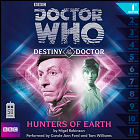 A year or so into their full-time residence on Earth, the Doctor and Susan try to live relatively normal lives incognito. The Doctor has quietly been stealing electronic components to fix the TARDIS, while Susan attends nearby Coal Hill School. While spending time with her friends (who still regard her interests in science and history as unusual), Susan experiences a severe headache and is then attacked by her fellow students, who are acting strangely (and in some cases, violently). Moments after the Doctor arrives to take her home, a radio disc jockey makes a cryptic dedication to “the Doctor and Sue”, along with a message that makes it clear that someone knows they are time travelers. A newspaper advertisement for electronic parts draws the Doctor’s attention, and he’s not entirely surprised when it turns out to be a trap laid for him. Susan experiences more displays of violence by her fellow Coal Hill students, including some she regards as her friends. In the junkyard at Totter’s Lane, someone scrawls the message “ALIENS OUT” – but how far are they willing to go to make that happen?
A year or so into their full-time residence on Earth, the Doctor and Susan try to live relatively normal lives incognito. The Doctor has quietly been stealing electronic components to fix the TARDIS, while Susan attends nearby Coal Hill School. While spending time with her friends (who still regard her interests in science and history as unusual), Susan experiences a severe headache and is then attacked by her fellow students, who are acting strangely (and in some cases, violently). Moments after the Doctor arrives to take her home, a radio disc jockey makes a cryptic dedication to “the Doctor and Sue”, along with a message that makes it clear that someone knows they are time travelers. A newspaper advertisement for electronic parts draws the Doctor’s attention, and he’s not entirely surprised when it turns out to be a trap laid for him. Susan experiences more displays of violence by her fellow Coal Hill students, including some she regards as her friends. In the junkyard at Totter’s Lane, someone scrawls the message “ALIENS OUT” – but how far are they willing to go to make that happen?
adapted by Nigel Robinson
directed by John Ainsworth
music by Simon HuntCast: Carole Ann Ford (Susan), Tam Williams (Cedric)
Notes: Susan mentions the (fictional) band John Smith and the Common Men (An Unearthly Child, Fanfare For The Common Men). She began school in the autumn term in 1962, the same time as new schoolmaster Colonel Rook (retired) first appeared. She is more interested in news of the space race than in news of the cold war. The dedication read by the disc jockey is a message from the eleventh Doctor (The Time Machine). The Telstar satellite was launched in 1962, but ceased to function in February 1963. This is significant in dating the story: the Beatles are mentioned as being chart-toppers, and their first UK #1 single, “Please Please Me”, didn’t reach #1 until February 22nd, 1963 – one day after Telstar stopped communicating with Earth. Perhaps the Doctor’s commandeering of the satellite is what caused it to shut down, thus placing this story on the 22nd of February 1963.
Timeline: after Quinnis and before An Unearthly Child
LogBook entry and TheatEar review by Earl Green
Review: The nebulous, undefined time period prior to An Unearthly Child is a minefield for the unwary hoping to set a story there, especially if they’re trying to evoke the “feel” of Doctor Who in its infancy: no one referred to the first Doctor as a Time Lord, no one ever mentioned Gallifrey, and it hadn’t even been definitively nailed down whether or not the Doctor and Susan were human. Nigel Robinson errs on the side of caution and places this story within a year of An Unearthly Child, drenching it with then-recent references to 1962/1963 marvels such as the Beatles and Telstar.
But Hunters Of Earth cleverly manages to avoid becoming a troublesome “pre-UNIT alien invasion” story by grounding all of its menaces on the Earth: the only alien influence of any kind turns out to be the two (currently marooned) time travelers, and the unnatural powers turning the teenagers of Shoreditch against Susan and turning Colonel Rook against the Doctor is a leftover relic of human evil. The Doctor then creatively repurposes human technology to overcome the problem. But there’s a problem that remains at the end of the story: the Doctor and Susan have both now been on the receiving end of human xenophobia, and are left disturbed by what they’ve seen, explaining the Doctor’s paranoia in An Unearthly Child as well as Susan’s isolation from her classmates.
With that in mind, I suddenly want more stories set in this time frame.
